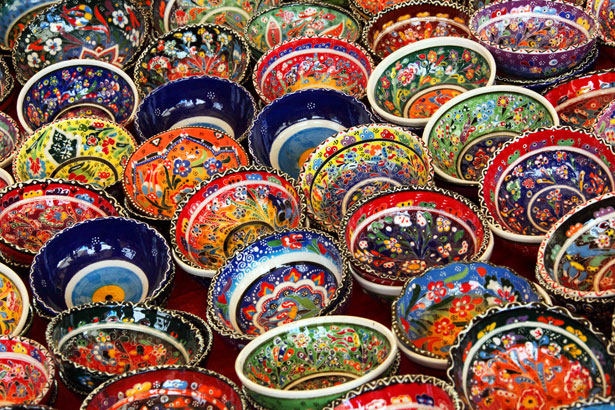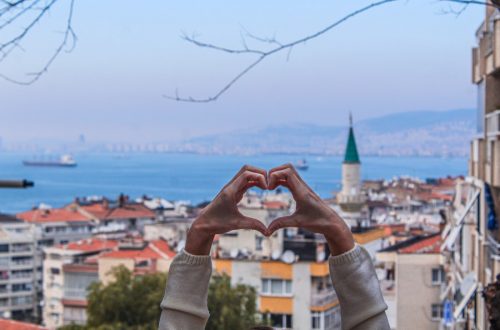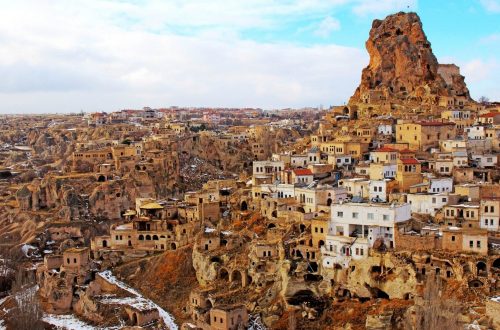
The Best 14 souvenirs from Turkey
Looking to buy souvenirs from Turkey ? Do you want to take a souvenir or a gift home with you?
I have narrowed down 14 ideal souvenirs from Turkey.
At the end of the post, you can decide and place your vote for the best souvenir.
You can find most of these souvenirs from Turkey in any one of the Turkish bazaars. One is held at least every week in the tourist resort areas. The best way to find out about market days is by asking the staff at your hotel.
If you don’t want to, or can’t wait for the bazaar day, that’s not a problem. There will surely be a market in some neighbouring town.
Gifts and souvenirs from Turkey
1. Turkish Eye (Nazar amulet)
In addition to the Turkish national flag, one Turkish symbol has become an integral part of public life. Taxi drivers hang it on their rear-view mirror. Women wear it as an arm chain and the entrances of homes are often decorated with it.
I’m talking about the Turkish eye, the Nazar amulet. It’s kind of a lucky charm. It promises to protect its wearer from the “Evil Eye”.
The piece of jewellery, shaped in the shape of a small blue eye, can be bought in a wide variety of shapes. There are pendants, bracelets, rings and larger versions for the front door of people’s houses.
2. Turkish Honey (Lokum)
Turkish honey has been an exclusive sweet, served at the court of the Ottoman sultans. This is something to try when you are in Turkey. Then you will understand why, for a very long time, it was only reserved for the upper class .
3. Spices
The best known are the spice bazaar in Istanbul and the bazaar in Manavgat (on the south coast near Side). They offer the largest selection of middle eastern spices with a variety of different tastes and scents.
In tourist towns, there is a market day at least once a week. At least one dealer will specialize in spices. As always, it’s best to shop at the stalls where the locals buy their own goods for themselves.
4. Turkish Carpets (Oriental rugs)
Turkish carpets are sold throughout the tourist areas. However, you must be careful, especially if you are a foreigner.
The first, most important rule for shopping in carpet dealers’ (and bazaars) shops is: Negotiate! That is what is expected of you. If you are quoted a price of 600 euros for a carpet? Then expect to buy it for 300 to 400 euros.
Do you want a real Turkish carpet, and not some fake one from China? Unfortunately, I cannot tell the difference between an original and an imitation. That’s why I can’t give you any better advice than to be careful.
Other than that, authentic Turkish carpets are very beautiful. Finely handcrafted, their patterns are based on the local traditions and customs. Decorations differ a little according to the region.
5. Pottery from Cappadocia
Pottery is not that common on the south coast. You can find more to choose from in the centre of Anatolia. Best known is the pottery from the town of Avanos in Cappadocia. These pots are made from the clay in Turkey’s longest river, the Kizilirmak.
If buying a clay jug is not enough, you can also make it yourself with an experienced potter in a workshop.
6. Copper dishes
Copper cookware and jugs were very popular during the Ottoman Empire.
In Antalya there is a narrow street with coppersmiths at the bazaar. They still manufacture their goods like they did hundreds of years ago. There, you can buy a samovar, a caydanlik, and all kinds of other copper goods.
7. Turkish coffee cups
The Ottoman Empire brought coffee to Europe. They first brought coffee from Ethiopia to the city of Mocha in Yemen. From there, it spread throughout the Mediterranean region within a very short time. That is why Turkey has one of the oldest coffee cultures in the world. The first coffee house, for example, opened in Istanbul in the 15th century.
A traditional Turkish coffee set consists of a brass or copper cup with a saucer and a lid. There is space for a porcelain cup in it. While shopping, you should, as always, make sure that the coffee service is really made in Turkey.
8. The Turkish Nargile water pipe
In Turkey, the water pipe is called the Nargile. It is one of the symbolic items from the country’s ancient Ottoman culture. Due to the many shisha / narghile bars in European countries, this custom has become just as well known in European countries as it is in Turkey.
A real Turkish nargile makes a wonderful gift for yourself or others. Always be careful not to buy them at any market stall. The chance of getting a nargileh “Made in Taiwan” is pretty good.
You can’t go wrong with the brands Elmas narghile, El Nefes and Tek Demir. The order reflects the quality and, accordingly, the price. In France you can buy a Tek Demir nargileh from 80 to 100 euros. In Turkey, it will cost you half of that.
9. Fruit and vegetables at the Bazaar
I always bring food from home to my apartment in Alanya. There are some things that I can’t do without: Parmesan, sausage, mozzarella, etc. Unfortunately, these items are not available in my neighbourhood Migros or Bim store. Because of this, I have next to nothing in my suitcase besides food.
On my way home, I pick up fresh tomatoes, figs, pomegranates and everything that the season has to offer. The fresh fruit and vegetables simply taste much better than packaged supermarket food.
10. Oriental / Turkish lamps
The basic concept of the lamps has been implemented in all Arab countries. They are hand-crafted from countless small mosaic stones. Other variants are made of copper or brass. Decorations and shapes differ, depending on the region and country.
Pay close attention to the quality of the lamp. They should be made of brass or copper. (Some are also silver-plated) Plastic usually means an import from China or a mass production.
Small flaws in the design do not indicate a lack of quality. If the mosaic stones are set half a millimetre differently here and there, that means it was crafted by hand.
11. Ceramic plate
Ceramic handicraft has a long tradition in Turkey. The best-known manufacturer is Kütahya. She used to supply the courts of the Ottoman sultans. These brightly painted plates are now being sold in large quantities in souvenir shops and bazaars. They are basically intended to be displayed as souvenirs from Turkey. You can’t put them in your dishwasher.
Pay special attention to the quality of the plates. There should be no cracks in the ceramic or the glaze. The patterns should also be as free of errors as possible. Small inaccuracies are not a problem. Machine-made plates look the same. A brushstroke that is a little inconsistent, a millimetre apart in different places, indicates manual work.
12. Bric-a-brac
You can find similar tourist goods in Turkey as in all the other countries. The classics are refrigerator magnets with Turkish national symbols such as Whirling Dervishes, the Blue Mosque, Bosporus Bridge or tulips.
Of course, there are also T-shirts and all sorts of novelty items and clothing.
13. Brand name Counterfeit products ???
The bazaars are full of counterfeit branded products from all over the world. A Lui Vuitton bag for 50 euros? No problem. Michael Kors handbags for 40 euros? Of course, you’ll find huge quantities of them. Clearly, the bags are only bought because of their name. In terms of quality, they don’t even match their bazaar price . So, be prepared to negotiate, as always.
14. Lion’s milk, the aniseed liqueur
Aslan Sütü, “the lion’s milk”. This is how the aniseed liqueur is often referred to in Turkey. The name comes from its milky colour, which is obtained in a glass after mixing it with water and ice. You should always mix the water first before adding the ice. Otherwise, it will be diluted and lose its aniseed taste!
The most popular brands in Turkey are Yeni Raki and Tekirdag Raki. The second one comes from the Tekirdag wine-growing region along the Marmara Sea. It is considered one of the best raki liqueurs in all of Turkey.
You can find Yeni Raki in almost all the large supermarket chains such as Migros. So far, I haven’t seen Tekirdag Raki in every store.
When you leave Turkey, you must be familiar with the customs regulations.
You are allowed to bring a maximum of one litre of liqueur into the EU.
The bottle must be stowed away in the checked baggage compartment of the aircraft.
Now it’s time to Vote! Which are the best souvenirs from Turkey to bring home?
Everyone’s tastes are very different. So, be sure to share your opinion in the comments section below!



